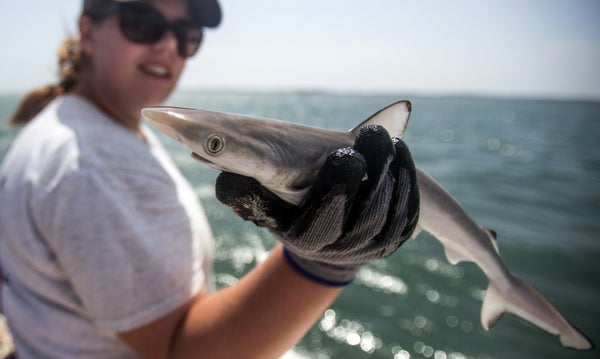First ‘Cocaine Sharks’ Discovered off Brazil

Sharks in Brazil Test Positive for a Surprising Contaminant: Cocaine
Cocaine has been detected in sharks for the first time, but scientists aren’t sure of the impact

Researchers found cocaine in sharpnose sharks off Brazil. These sharks are in the same genus as the Atlantic sharpnose shark, shown here with a student researcher near Cape Lookout in the Outer Banks of North Carolina.
Tegan Johnston/Raleigh News & Observer/Tribune News Service via Getty Images
Sharks swimming off the cost of Brazil have something a little startling coursing through their systems: cocaine.
The drug had never previously been found in wild sharks. But that doesn’t mean these fish are unique; scientists just hadn’t previously tested any shark for coke. The effort was a slam dunk, with the 13 sharks that were examined all testing positive for the drug in their muscles and liver, according to a new study in Science of the Total Environment.
What this means for the sharks is an open question, say the study co-authors Enrico Mendes Saggioro and Rachel Ann Hauser-Davis, an ecotoxicologist and a biologist, respectively, at Brazil’s Oswaldo Cruz Foundation. No one has ever studied the behavioral or physiological impacts of cocaine in sharks, Hauser-Davis says, but her ongoing research on environmental contamination in these apex predators suggests the notorious drug is only one of the animals’ worries.
On supporting science journalism
If you’re enjoying this article, consider supporting our award-winning journalism by subscribing. By purchasing a subscription you are helping to ensure the future of impactful stories about the discoveries and ideas shaping our world today.
“We detected high levels of metals and also detected ‘forever chemicals’ [perfluoroalkyl and polyfluoroalkyl substances, or PFASs], pesticides and polycyclic aromatic hydrocarbons, PCBs and PBDEs in over 30 shark and ray species,” Hauser-Davis says. PCBs, or polychlorinated biphenyls, are carcinogenic chemicals banned by the U.S. in 1976 and by signatories of the United Nations’ Stockholm Convention in 2001. PBDEs, or polybrominated diphenyl ethers, are flame retardants that can disrupt brain development and hormones.
The researchers became interested in drug testing sharks after Mendes Saggioro detected cocaine while researching river water contaminants in Brazil’s state of Rio de Janeiro. Brazil has an estimated 1.5 million cocaine users, according to the World Drug Report 2020 And many areas in the country lack sewage treatment, meaning drug-contaminated urine goes right into waterways. Drug runners may also sometimes dump loads of cocaine into the ocean to avoid a bust. A Discovery Channel Shark Week special in 2023 explored the notion that sharks might take bites of floating cocaine bales, and it found that sharks did investigate dummy packages dropped near the Florida Keys. But researchers don’t think that’s the main way drugs enter sharks’ system. A 2007 study in Florida found that bull sharks have been contaminated with prescription medications via failed sewage systems. Other fish, which are a very common prey for sharks, have also been shown to be contaminated—so sharks may be exposed directly in the water or take on these compounds from their diet. Given the ubiquity of legal pharmaceuticals showing up in aquatic animals, “to think that you wouldn’t find cocaine or other illegal drugs in sharks is kind of crazy,” says Chris Lowe, a marine biologist and director of the Shark Lab at California State University, , Long Beach, who was not involved in the new study.
The researchers in this study tested Brazilian sharpnose sharks (Rhizoprionodon lalandii), a small species that lives near coastlines, from the waters off Rio de Janeiro. They found an average cocaine concentration of 23 micrograms per kilogram in the sharks’ tissue, as well as an average concentration of seven micrograms per kilogram of benzoylecgonine (the compound that cocaine breaks down into as it is metabolized). This is a fairly low level: studies on the impact of cocaine in humans tend to use doses of around 0.4 milligram per kilogram of body weight (one milligram equals 1,000 micrograms). Female sharks had higher concentrations of cocaine than males, however, and half of the females that were caught were pregnant. Previous research on stingrays, which are relatives of sharks, suggests they can pass on environmental contamination to developing fetuses.
“Adults may have better developed immune systems or enzyme systems to metabolize some of those things, but a developing fetus may not,” Lowe says. “We really don’t know what the developmental impacts could be.”
Mendes Saggioro plans to continue drug testing sharks in the area and to expand this to rays that live in the nearby estuary to see how far the contamination extends. He and his team also want to look at cocaine concentrations in migratory fish that spend less of their life near coastlines.
While researchers unravel the consequences of cocaine-contaminated sharks, there are two major takeaways. One comes from Mendes Saggioro and Hauser-Davis: don’t eat sharks because the animals are both overfished and full of compounds you don’t want in your body.
David Shiffman, a marine conservation biologist at Arizona State University, notes the other takeaway, which focuses on the health of the sharks themselves: “Please don’t dump your trash, including illegal drugs, into the water,” he says.




